From Davis‘ As America Falls series.

Regina Hackett takes her Art to Go
From Davis‘ As America Falls series.

I watch So You Think You Can Dance for the dancers and a few of
its choreographers, including Travis Wall, Napoleon and Tabitha D’umo
(Nappy Taps), Shane Sparks, Mandy Moore, Sonya Tayeh and Tyce
DiOrio for his contemporary, not Broadway. His Broadway is dead move on
dead move. Week after week, however, dancers push past whatever
grindingly obvious theme the choreographers hand them to create a
genuine moment or two. However bad the choreography, dancers manage to
redeem it. When the right choreographer meets the right dancer, which
happens at least once an episode, the result is thrilling.
Dance
critics tend to dislike the show, for good reason. (Watch Travis Wall’s
fake audition in which he crams every slam-bam cliche for which the show
is know into a 3-minute, cross-dressing routine that manages while extremely corny, to be great. Choreographer dim, dancer killer.)
But the real problem is the judges.
With
her vehement and irrational distaste for first Brandon Bryant and this
season’s Adechike Torbert, Mia Michaels appears to be unable to bear the sight of heavily muscled black men. (Slender black men are, in her book, OK.) Two geysers of crazy aren’t enough evidence of conscious racism, but
unconscious? Hell yes, especially because Michaels comes from the
unedited id school of criticism. Whatever she’s feeling, she says. In
the end, unconscious is more insidious. When sleep walkers commit a
crime, they wake up indignant at the charge.
In the dance context, however, nothing out of Michaels’ mouth comes close to the stupidity of Nigel Lythgoe’s comment last week. Addressing a dancer, he said:
You are not the artist at the end of the day. The choreographer is. You are the artist’s brush if you like….
Following
that reasoning, actors aren’t artists either. Nor are singers, unless
they wrote the song. What about musicians? (Yes to Mendelssohn, no to
Isaak Perlman?) I can’t remember reading or hearing anything as
wrong-headed about an art form. Is he what we have to put up with to
see dance on TV? Can Michaels employ a personal diversity trainer to address the root of her
problem or will she go on and on, making life hell for the type of male
black dancer she fears and/or hates?
How many people responsible for the more than 31 million hits in seven weeks to a Katy Perry video realize that its chief asset comes from Will Cotton? Those who know he provided the visuals knew it already or dug for it. His name isn’t on the link.
 Shot from the video:
Shot from the video:
 Naturally, teen sites are panting, but we can expect more from art writers, right?
Naturally, teen sites are panting, but we can expect more from art writers, right?
Here’s Emma Allen on Artinfo:
When someone calls to tell you that candy-sweet pop star Katy Perry is in pastry-loving painter Will Cotton’s
studio, and will talk to you about the nude portrait she commissioned
from him for the cover of her latest album (“Teenage Dream”), but only
if you get in a cab immediately, and then run through the streets of the
Lower East Side — well, you do it.
A girl’s gotta do what a girl’s gotta do. Doubtless Perry’s Cotton-fueled sensation has sent legions of pop music art directors into art galleries to find another hit maker. I hope they follow Perry’s excellent example and pay the artist. Giving the artist credit on the product would also be laudable.
One: Think of where you want to go.
John Grade
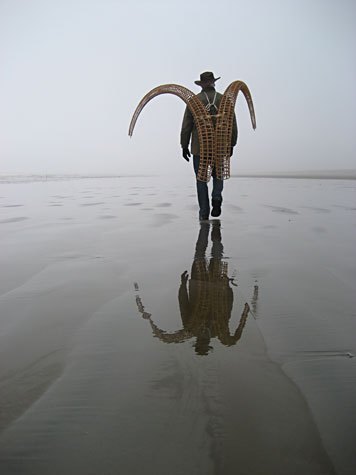 Two: Take your time.
Two: Take your time.
Adam Ekberg
 Three: Use your arms.
Three: Use your arms.
Roger Ballen

Can you stop time? Only if you’re a magazine long sealed into its own irrelevance. Even there, however, securely out of date, Time can occasionally leak into the present moment. I refer to its cover photo of a young woman whose nose and ears were cut off by the Taliban for the crime of escaping back to her family. To call the Taliban a medieval madness is to insult the Dark Ages. (Where are the Taliban’s cathedrals, tapestries, songs, poems and illuminated manuscripts?) What’s shared is a mobilizing energy. As the Catholics liked to say, “The blood of the martyrs is the seed of the Church.” Against that energy, our blundering intrusions are unlikely to accomplish anything of lasting value. The negatives are plain to anyone, and they are spreading, like the seeds of the Church.
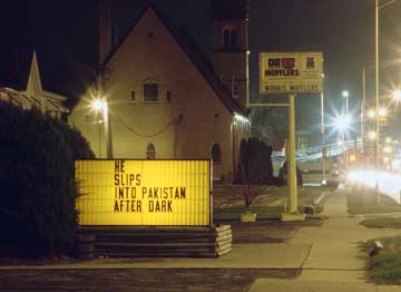 Damaged, brutal, in the wrong against a deeper wrong, we go on, not on their side and not on our own. Given the intractable hatred of their countrymen, what can Afghan women expect from us?
Damaged, brutal, in the wrong against a deeper wrong, we go on, not on their side and not on our own. Given the intractable hatred of their countrymen, what can Afghan women expect from us?
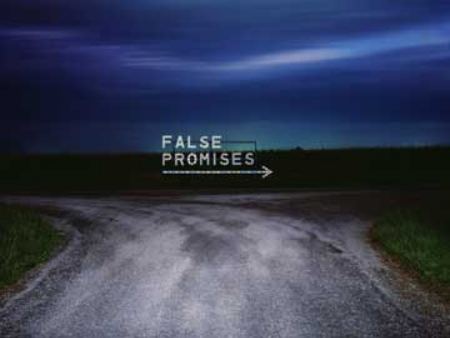
Whitney Biennial curators aren’t the only ones skipping Seattle. Skipping Seattle has deeper roots in the cultural landscape.
Below, Jack Kerouac. “NIGHT NOTES & Diagrams for ON THE
ROAD.” Manuscript notes for the novel, November 1949. New York Public
Library, Berg Collection, Jack Kerouac Archive, via.
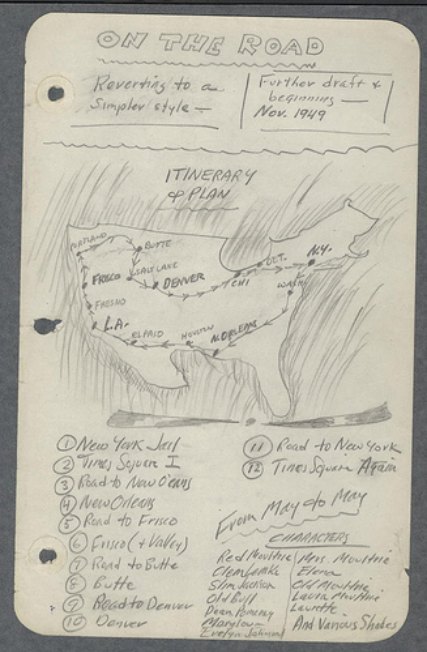
Or so it says on the cake.
Lee is this year’s winner of the Stranger’s Genius Award in visual art, which.comes with a cheap cake and a sizable check: $5,000. Lee is the essence anti-spectacle. Her Frequency Map (2007) at Lawrimore Project was a room empty save for the sporadic sound of soft knocking, answered by barely audible raps. When visitors left, the room tried to whistle them back, as if it were a void with needs. The room grew louder as it shuffled through its pickup moves, hoping to score.
In Fugue State, hands play across a cast resin pillow, slipping in and out of each other’s embrace. A force drives a fuse in Conjugal, thumping through the cotton batting of a mattress interior. Lee tracked oil drops swimming through water in Wake Up as she played Bach on the piano.
Conjugal, 2006, video
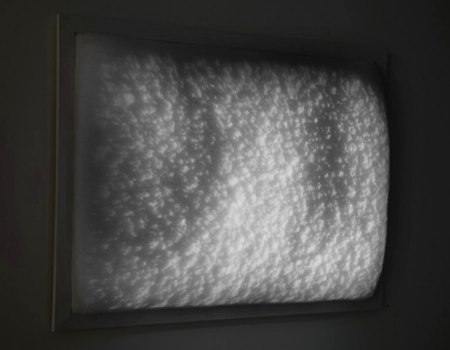 Lee has also served as curator, focused on what a devotion to the muck of clay does to contemporary artists. (Wet and Leatherhard at Lawrimore Project, review here.) Her videos here. Jen Graves on Lee’s selection here.
Lee has also served as curator, focused on what a devotion to the muck of clay does to contemporary artists. (Wet and Leatherhard at Lawrimore Project, review here.) Her videos here. Jen Graves on Lee’s selection here.
In the mid-1990s, Charles Krafft and Larry Reid decided to do something about the past-tense reputation of Krafft’s personal hero.
Enter the Mystic Sons of Morris Graves, Lodge No. 93.
 In draping a mantle of irony and subversive humor over the spiritual head of the Northwest School, Krafft and Reid were pushing what Krafft called “resurgent regionalism through mythomania.” Graves’ profile had become fogged with the dewy breath of his mythy-minded admirers, and Krafft and Reid hoped to clear it with satire.
In draping a mantle of irony and subversive humor over the spiritual head of the Northwest School, Krafft and Reid were pushing what Krafft called “resurgent regionalism through mythomania.” Graves’ profile had become fogged with the dewy breath of his mythy-minded admirers, and Krafft and Reid hoped to clear it with satire.
Satire and strategy. Like a Stephen Sondheim stripper in Gypsy, they got nothing against a gimmick.
You can pull all the stops out
Till they call the cops out,
Grind your behind till your banned,
But you gotta get a gimmick
If you wanna get a hand.
You can sacrifice your sacro
Workin’ in the back row,
Bump in a dump till your dead.
But you gotta get a gimmick
If you wanna get ahead.
Krafft:
We’re taking out the sanctimony and adding a bit of titillation. The
Northwest mystics were an urban movement, not a bunch of remote
dreamers. They didn’t have master of fine arts degrees. They learned on
the job.
 Besides membership charters, wristwatches, calendars, trading cards, ashtrays, portable shrines and even a theme song written by Krafft and sung to the tune of The Beverly Hillbillies, what has the Mystic Sons done for us lately?
Besides membership charters, wristwatches, calendars, trading cards, ashtrays, portable shrines and even a theme song written by Krafft and sung to the tune of The Beverly Hillbillies, what has the Mystic Sons done for us lately?
Reid is glad you asked.
Thursday night, 5:00 to 8:00 at 3 galleries in the
Tashiro Kaplan compound (Rock/DeMent, the Corridor, and Angle galleries
at 306 S. Washington St) is a Graves’ tribute invitational, with a Graves séance on August 28, what would have been Graves’ 100th birthday.
Morris Graves, Self Portrait, (left); John Ohannesian, Morris Graves (right)

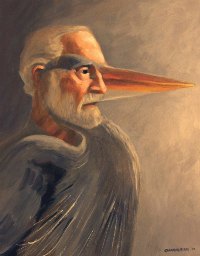
(Reid’s press release after the jump.)
an ArtsJournal blog


